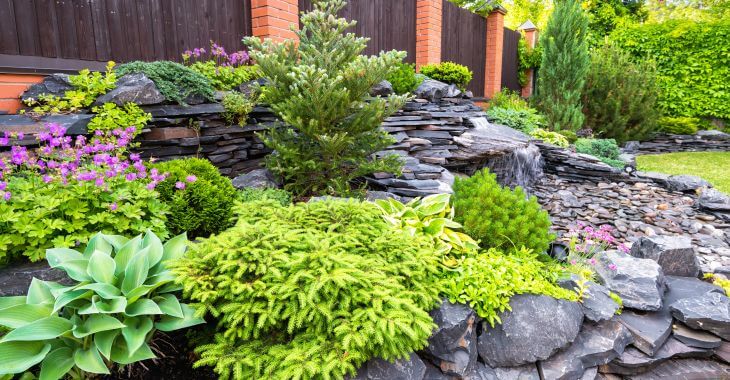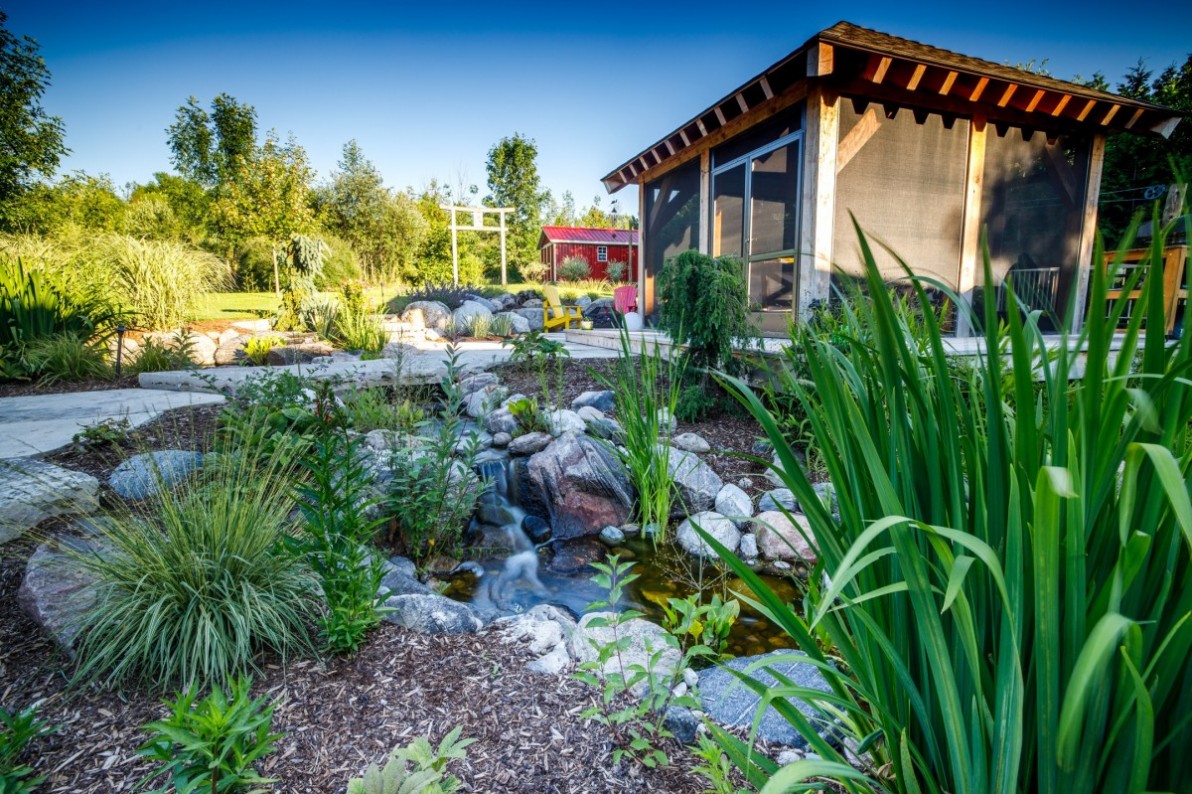A Practical Guide to Hardscaping from Landscaping St. Louis MO
Check Out Ingenious Techniques to Improve Your Home's Aesthetic Through Landscaping
Exploring innovative landscape design strategies can transform a property's aesthetic and performance. By incorporating native plants and hardscaping, house owners can produce sustainable and organized settings. Furthermore, the thoughtful use of shade theory and water attributes enhances aesthetic appeal. As exterior rooms come to be expansions of the home, understanding exactly how to combine these elements successfully is vital. This discussion will reveal methods that boost both charm and usability in exterior settings.
Embrace Indigenous Plants for Sustainability
As climate change and city development proceed to affect local ecological communities, welcoming native plants for sustainability has actually become increasingly important. Native plants are well-adapted to regional environments, soil kinds, and wild animals, requiring less water and fewer chemical inputs contrasted to non-native types. Their growth sustains neighborhood biodiversity, cultivating habitats for pollinators, birds, and other wildlife. By integrating indigenous vegetation right into landscapes, homeowner can create dynamic, lasting settings that show the region's natural beauty.Furthermore, indigenous plants boost soil wellness by promoting advantageous microorganisms and reducing disintegration. They also contribute to carbon sequestration, aiding alleviate environment adjustment results. The aesthetic allure of indigenous gardens can be equally as captivating as conventional decorative layouts, showcasing seasonal blooms and differed textures. Ultimately, welcoming native plants not just supports ecological equilibrium but also improves the neighborhood's visual landscape, urging a deeper link to the environment.
Integrate Hardscaping for Framework and Function
Hardscaping plays a vital function in improving both the framework and capability of exterior spaces - st louis landscaping companies. By selecting sturdy materials and tactically intending the design, homeowners can create versatile environments that match their landscaping. The assimilation of hardscape elements not just adds aesthetic passion yet additionally serves practical objectives, such as boosting ease of access and handling water drainage
Advantages of Hardscaping
While numerous homeowners focus mostly on softscaping elements, integrating hardscaping into a landscape layout uses numerous advantages that boost both framework and function. Hardscaping, that includes features such as patios, pathways, and preserving walls, supplies a solid structure for outdoor spaces. It creates defined areas that boost motion and usability, encouraging outside tasks and celebrations. Furthermore, hardscaping can aid handle water drainage, decreasing erosion and promoting healthier plant life. These functions add visual appeal, contributing to the general design harmony of a building. By balancing softscaping with hardscaping, property owners can create aesthetically striking landscapes that are not only lovely but additionally useful and sustainable for many years ahead.
Products for Durable Style
Including hardscaping not just boosts the visual allure of exterior spaces however likewise depends heavily on the selection of materials that ensure durability and functionality. Premium concrete, natural rock, and brick are preferred choices for pathways, outdoor patios, and wall surfaces, offering a robust foundation that withstands weather condition elements and heavy foot web traffic. Composite products provide the look of timber without the upkeep, making them suitable for decking and fence. Additionally, permeable pavers enable for effective water drainage, promoting environmental sustainability while keeping structural integrity. Steel accents such as barriers and sculptures can introduce modern flair and strength. By selecting the right products, homeowner can develop aesthetically striking landscapes that stand the examination of time and improve their outside living experience.
:max_bytes(150000):strip_icc()/GettyImages-154046398-c39f1daf45a84601b328d78ed8630660.jpg)
Planning Practical Outdoor Spaces
Just how can one properly prepare outside spaces that balance visual appeals with capability? Incorporating hardscaping elements is necessary in achieving this equilibrium. Attributes such as patios, walkways, and retaining wall surfaces not only provide structure however also enhance the visual charm of the landscape. By strategically positioning these components, one can develop defined locations for tasks like enjoyable, horticulture, or relaxation.Moreover, selecting materials that complement the natural environments can boost the total visual. Making use of all-natural rock or decorative pavers can incorporate perfectly with greenery. Additionally, hardscaping can aid in drain and dirt stabilization, ensuring a sustainable exterior setting. Eventually, thoughtful planning that combines hardscaping with landscape layout brings about welcoming, practical outdoor rooms that accommodate numerous demands.
Produce Multi-Functional Spaces for Outdoor Living
Producing multi-functional rooms for outdoor living boosts the usability and pleasure of a landscape. By integrating outside eating areas and relaxation areas, home owners can maximize their outside experience. These attentively created spaces advertise social communication while providing tranquil settings for taking a break.

Exterior Eating Areas
While numerous home owners seek to improve their outside areas, transforming a yard right into a useful dining location can raise both visual appeals and use. Outdoor dining locations offer an inviting atmosphere for events, permitting families and close friends to enjoy meals in a natural setting. Including elegant furniture, such as weather-resistant eating tables and chairs, develops a comfy experience. Including attributes like pergolas or shade sails can offer defense from the aspects while providing visual passion - Landscaping St. Louis MO. Decorative elements, such as string lights or lanterns, can boost atmosphere throughout evening dishes. Additionally, incorporating neighboring planters or yard beds includes greenery, creating a cohesive appearance. Eventually, a properly designed outside dining space fosters connection and enjoyment, improving the overall outdoor living experience
Leisure Zones
Relaxation zones function as essential components of exterior living, supplying a tranquil getaway where people can relax and charge. These spaces can be creatively designed to incorporate numerous components that enhance convenience and serenity. Incorporating features such as hammocks, lounge chairs, or outdoor sofas invites relaxation while adding visual charm. Soft illumination choices, like string lights or lights, can create a comfortable atmosphere for evening events. Additionally, integrating natural environments such as water functions, plants, and landscaping can better enhance the ambiance. By mixing capability with beauty, leisure zones come to be flexible areas for reflection, analysis, or delighting in peaceful moments with nature, inevitably transforming exterior spaces into inviting resorts that accommodate both leisure and social communication.
Use Shade Theory to Design Vibrant Landscapes
Shade concept plays a pivotal role in developing lively landscapes, as it influences the emotional and psychological actions of customers. By recognizing how colors communicate, landscape designers can produce harmonious environments that evoke details feelings. As an example, Clicking Here warm colors such as reds and oranges can stimulate an area, making it really feel vibrant and welcoming, while cooler tones like blues and eco-friendlies promote tranquility and relaxation.Incorporating contrasting shades can likewise improve aesthetic rate of interest. Designers frequently use corresponding color pattern-- colors contrary each various other on the color wheel-- to produce striking focal points. In addition, using seasonal plants permits for a vibrant color palette that alters throughout the year, preserving visual appeal.Moreover, the critical positioning of colors can assist the audience's eye via the landscape, creating a sense of flow and unity. Inevitably, a thoughtful application of color theory raises a landscape, enhancing its visual and emotional impact.

Apply Water Attributes for Tranquility and Allure
Integrating water features into landscape style can noticeably enhance both peace and aesthetic appeal. These components, such as fish ponds, water fountains, or waterfalls, introduce soothing audios and bewitching visuals that draw focus and create a peaceful environment. The mild circulation of water can mask unwanted noise, offering a serene hideaway from the outside world.Moreover, water attributes draw in wild animals, such as birds and butterflies, enhancing the ecological community and including vibrant life to the landscape. Purposefully positioned, they can work as centerpieces, guiding the customer's eye and improving the total composition of the exterior space.In enhancement to visual benefits, water functions can also improve the microclimate, giving cooling effects during hot climate. When designed attentively, these setups balance with bordering plants and hardscapes, creating a cohesive and welcoming setting. Inevitably, water functions are a versatile tool in landscape style, promoting beauty and harmony.
Experiment With Vertical Gardening Strategies
How can vertical horticulture transform limited rooms into rich, green resorts? This ingenious strategy utilizes walls, fencings, and trellises to produce a lively tapestry of plant life, even in restricted areas. By making the most of vertical area, house owners can grow a variety of plants, from natural herbs and vegetables to ornamental flowers, improving both aesthetic appeal and functionality.Vertical gardens not just supply a sensational visual influence but also enhance air quality and advertise biodiversity. They can be tailored to match different layout styles, from modern-day minimalist to rustic beauty. In addition, integrating modular planters enables easy reformation and seasonal updates, making certain the garden remains dynamic throughout the year.Choosing the right plants is essential; choosing those that thrive in upright arrangements will generate the very best results. Overall, experimenting with upright gardening strategies can efficiently redefine outside areas, transforming them right into green shelters that invite relaxation and satisfaction.
Use Lighting to Improve Atmosphere and Safety And Security
While effective landscaping can change outdoor rooms, the calculated use of illumination plays a vital role in improving both setting and safety. Attentively placed outdoor lighting can highlight building functions, yard paths, and one-of-a-kind plants, creating a welcoming environment. Soft illumination from lanterns or string lights can evoke a comfortable ambiance for night events, while spotlighting can stress centerpieces such as sculptures or water features.In addition to aesthetic improvements, lighting significantly adds to safety and security. Well-lit pathways and access factors reduce the threat of accidents, making navigating simpler night. Motion-sensor lights give an included layer of safety and security by illuminating locations when movement is spotted. By incorporating different illumination methods, home owners can attain a harmonious balance in between elegance and capability, ensuring that their outside areas remain both visually attractive and secure. Overall, efficient exterior lighting is an important part of detailed landscape layout.
Frequently Asked Concerns
How Can I Choose the Right Plant Kingdoms for My Climate?
Selecting the right plants for a details climate entails looking into local weather condition patterns, soil conditions, and native types. Consulting you can try here gardening sources and neighborhood experts can provide valuable understandings into suitable plant options for excellent growth and sustainability.
What Are the Maintenance Demands for Various Landscape Design Attributes?
The upkeep needs for landscaping features vary commonly. Some plants require routine pruning and watering, while hardscapes require occasional cleaning and repair work. Comprehending particular needs guarantees longevity and ideal look of each function in the landscape.
Just how Do I Allocate a Landscaping Task?
Budgeting for a landscape design task calls for reviewing prices for products, labor, and style. landscaping st louis. One ought to focus on needs versus wants, seek several quotes, and assign a backup fund for unanticipated expenditures to ensure financial expediency
Can I Landscape My Residential property Myself, or Should I Hire an Expert?
The private contemplated whether to embark on the landscaping project separately or get an expert. Weighing individual skills against prospective experience, they recognized that each alternative carried distinct benefits and obstacles, influencing their decision significantly.
What Are the very best Times of Year for Landscaping Projects?
The most effective times for landscape design tasks typically consist of early springtime and very early fall. These seasons use favorable climate condition, additional resources enabling plants to develop roots prior to extreme temperatures, ensuring a successful and vibrant landscape improvement.